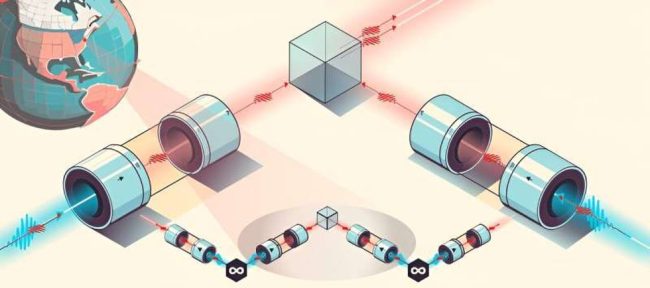Quantum networking is a cutting-edge field within quantum information science that explores the use of quantum mechanics principles to transmit and process information across networks. This article delves into the fundamentals, principles, applications, challenges, and future prospects of quantum networking, highlighting its potential to revolutionize communication and information processing.
Quantum networking aims to exploit quantum phenomena such as superposition and entanglement for transmitting and processing information. Key concepts include:
- Quantum Entanglement: A phenomenon where quantum particles become correlated in such a way that the state of one particle instantaneously influences the state of another, regardless of the distance between them.
- Quantum Superposition: The ability of quantum particles to exist in multiple states simultaneously until measured, enabling more information to be encoded and transmitted in quantum systems.
- Quantum Teleportation: A protocol that allows the transfer of quantum information from one location to another without physical transmission of particles, leveraging entanglement.
- Quantum Key Distribution (QKD): Using quantum properties to generate and distribute cryptographic keys securely, ensuring information transmitted over quantum networks remains private and immune to eavesdropping.
Principles of Quantum Networking
Quantum networking principles focus on harnessing quantum mechanics to achieve secure and efficient information transmission:
- Quantum States as Information Carriers: Quantum bits (qubits) encode information in quantum states, offering higher information density and computational power compared to classical bits.
- Entanglement-based Communication: Utilizing entanglement to establish secure communication channels and enable faster-than-light transmission of information through quantum teleportation.
- Quantum Repeaters: Devices designed to extend the range of quantum communication by mitigating signal loss and maintaining entanglement fidelity over long distances.
- Quantum Algorithms: Developing algorithms that leverage quantum parallelism and entanglement for solving complex problems, such as factorization and optimization, faster than classical computers.
Applications of Quantum Networking
- Quantum Secure Communication: Implementing QKD for secure data transmission, protecting against quantum hacking and ensuring confidentiality in sensitive communications.
- Quantum Internet: Building a global quantum internet infrastructure to enable secure and ultra-fast communication between quantum computers and quantum-enabled devices.
- Quantum Cloud Computing: Harnessing distributed quantum computing resources through quantum networks for performing complex computations and simulations.
- Quantum Sensor Networks: Using quantum sensors and metrology for precise measurements in fields such as navigation, imaging, and environmental monitoring.
Challenges in Quantum Networking
- Decoherence and Noise: Maintaining coherence of qubits over long distances and in noisy environments remains a significant challenge for quantum communication and computing.
- Scalability: Scaling up quantum networks to support large-scale deployment and integration with existing classical communication infrastructure poses technical and practical challenges.
- Technological Readiness: Developing reliable quantum repeaters, quantum memories, and quantum processors capable of handling practical applications in real-world scenarios.
- Standardization and Protocols: Establishing global standards and protocols for quantum networking to ensure interoperability, security, and compatibility across different platforms and implementations.
Future Trends in Quantum Networking
- Hybrid Quantum-Classical Networks: Integrating quantum and classical networking technologies to create hybrid networks capable of handling diverse applications and workloads.
- Quantum Cloud Services: Offering quantum computing resources and quantum networking capabilities as cloud services to accelerate research, development, and commercialization.
- Quantum-Safe Cryptography: Developing post-quantum cryptography protocols to secure classical and quantum networks against future quantum computing threats.
- Interdisciplinary Collaboration: Fostering collaboration between quantum physicists, computer scientists, engineers, and policymakers to advance research and development in quantum networking.
Conclusion
Quantum networking holds immense promise for transforming communication, computing, and information security in the coming decades. As researchers and engineers continue to overcome technical challenges and explore new applications, quantum networking is expected to play a pivotal role in shaping the future of information technology, enabling unprecedented levels of security, speed, and efficiency in global communication networks. Embracing quantum networking technologies represents a significant leap towards harnessing the full potential of quantum mechanics to address complex challenges and drive innovation in the digital era.
